Advances in Highly Ductile Concrete Research
Abstract
1. Introduction
2. Basic Properties of Highly Ductile Concrete and Fibers
2.1. Basic Characteristics of HDC
2.2. Different Fiber Properties
3. Mechanical Properties of HDC
3.1. Static Mechanical Properties of HDC
3.1.1. Effect of Different Fibers and Dosage on HDC Performance
3.1.2. Mechanical Properties of HDC in Different Environments
3.2. Dynamic Mechanical Properties of HDC
4. Effect of Salt Erosion and Wet–Dry Cycling, Salt Freeze–Thaw Environments on HDC Durability
4.1. Effect of Salt Erosion and Wet–Dry Cycling on the Performance of HDC
4.2. Effect of Coupled Salt Freeze–Thaw Cycles on HDC Performance
5. Microscopic Studies and Engineering Applications of HDC
5.1. Microscopic Studies
5.2. Engineering Applications
6. Conclusions
- At present, HDC has not been fully utilized, its quality cannot be guaranteed in actual projects, the construction is difficult, and it is difficult to accurately use in different construction processes and different environments. This is still an important problem facing its use; in response to the above problems, researchers can use the factory production method to carry out a special production line to ensure its production quality.
- Ordinary HDC has a tensile strain capacity (strain at peak tensile stress) of 3–5% and a tensile strength of 3–7 MPa. Although HDC has a good tensile strain capacity, its ductility is not sufficient to ensure that it can be used as a structural material without reinforcement, especially under extremely harsh conditions.
- The mechanical anisotropy and interlayer bond strength of 3D-printed UHDC need to be studied more systematically from both experimental and numerical aspects. In addition, it is also necessary to consider the introduction of bionics in 3D-printed structures, and the design of different types of release structural components, such as bamboo columns, pearl beams, honeycomb panels, etc. For the 3D printing of special-shaped components, the shotcrete process is used, which makes the structure formation simpler and faster, eliminating the process of removing the external template.
- At present, there is insufficient research on the effect of the mechanical properties of HDC after high temperature in terms of the resting time, and the strength degradation law of fiber-reinforced cementitious materials under the mutual influence of factors such as temperature, cooling mode and resting time has not been adequately investigated. Also, there is still a need to deepen the research on the consideration of HDC’s resistance to dry and wet cycling and sulfate erosion.
- Research on the HDC of salt erosion under the coupling of wet and dry cycles and freeze–thaw cycles can help engineers to more accurately assess the safety of the structure, identify potential safety hazards in a timely manner, and provide targeted maintenance measures for the existing concrete structure, thus improving the quality and service life of the concrete structure and reducing the high repair and reconstruction costs at a later stage.
- The fiber-mesh-reinforced cement mortar (TRM) reinforcement technique can improve the stress performance of members, but there are certain defects, such as low matrix elongation, a large crack width, and no longer transferring loads after cracks appear.
Author Contributions
Funding
Institutional Review Board Statement
Informed Consent Statement
Data Availability Statement
Conflicts of Interest
Nomenclature
References
- Zhang, R.W.; Wang, Q.C.; Zhang, R.L.; Dai, J.P.; Zhang, K.; Wang, B.Z. Study on the influence of curing condition and age on the strength and permeability of air-entrained concrete. Silic. Bull. 2017, 1, 161–167+172. (In Chinese) [Google Scholar] [CrossRef]
- Qiao, Y.; Wang, H.; Cai, L.; Zhang, W.; Yang, B. Influence of low temperature on dynamic behavior of concrete. Constr. Build. Mater. 2016, 115, 214–220. [Google Scholar] [CrossRef]
- Fischer, G.; Li, V.C. Influence of matrix ductility on tension-stiffening behavior of steel reinforced engineered cementitious composites (ECC). Struct. J. 2002, 99, 104–111. [Google Scholar]
- Wu, X.-X.; Xie, Q.; Zhao, P.; Jing, Y.-W.; Lin, M. Research on seismic performance of masonry walls reinforced by ultra-high ductility concrete. J. Disaster Prev. Mitig. Eng. 2023, 1–8. (In Chinese) [Google Scholar] [CrossRef]
- Liu, H. High Ductility of Concrete Fatigue Properties and Damage Mechanism Research. Ph.D. Thesis, China Civil Aviation University, Tianjin, China, 2022. (In Chinese) [Google Scholar] [CrossRef]
- Li, M.; Li, V.C. Influence of material ductility on performance of concrete repair. ACI Mater. J. 2009, 106, 419–428. [Google Scholar]
- Kabele, P.; Kanakubo, T. Experimental and numerical investigation of shear behavior of PVA-ECC in structural elements. In Proceedings of the 5th International RILEM Workshop on High Performance Fiber Reinforced Cement Composites (HPFRCC5), Mainz, Germany, 10–13 July 2007; pp. 137–146. [Google Scholar]
- Deng, M.K.; Pan, J.J.; Han, J.; Liang, X.W. Experimental study on seismic behavior of shear wall strengthened with high ductile concrete. J. Build. Struct 2019, 40, 45–55. [Google Scholar]
- Yin, Y.; Qiu, B. Experimental study on mechanical properties and early cracking of polyvinyl alcohol fiber concrete. Silic. Bull. 2019, 38, 454–458. (In Chinese) [Google Scholar] [CrossRef]
- Bai, L.; Zhou, F.; Xie, P.F.; Wang, Z.P. Experimental study on mechanical properties of high ductivity fiber-reinforced cement-based composites. Ind. Build. 2017, 47, 108–113. (In Chinese) [Google Scholar]
- Deng, M.K.; Pan, J.J.; Qin, M.; Liu, H.B. Uniaxial compression constitutive model of high ductivity concrete. J. Xi’an Univ. Archit. Technol. (Nat. Sci. Ed.) 2016, 48, 826–831. (In Chinese) [Google Scholar] [CrossRef]
- Sun, M.; Zhu, J.; Sun, T.; Chen, Y.; Li, X.; Yin, W.; Han, J. Multiple effects of nano-CaCO3 and modified polyvinyl alcohol fiber on flexure–tension-resistant performance of engineered cementitious composites. Constr. Build. Mater. 2021, 303, 124426. [Google Scholar] [CrossRef]
- Pan, Z.; Wu, C.; Liu, J.; Wang, W.; Liu, J. Study on mechanical properties of cost-effective polyvinyl alcohol engineered cementitious composites (PVA-ECC). Constr. Build. Mater. 2015, 78, 397–404. [Google Scholar] [CrossRef]
- Zhang, J.; Ju, X.-C.; Guo, Z.-L. Effect of PVA fiber diameter on the tensile properties of cement-based composites. J. Build. Mater. 2009, 12, 706–710. (In Chinese) [Google Scholar]
- Wang, Q.; Lai, M.H.; Zhang, J.; Wang, Z.; Ho, J.C.M. Greener engineered cementitious composite (ECC)–The use of pozzolanic fillers and unoiled PVA fibers. Constr. Build. Mater. 2020, 247, 118211. [Google Scholar] [CrossRef]
- Said, M.; Mustafa, T.S.; Shanour, A.S.; Khalil, M.M. Experimental and analytical investigation of high performance concrete beams reinforced with hybrid bars and polyvinyl alcohol fibers. Constr. Build. Mater. 2020, 259, 120395. [Google Scholar] [CrossRef]
- Wu, M.; Wu, J.; Yan, Q.; Li, L.; Wu, W. Study on static tensile properties and mechanical model of steel-mesh PE fiber cement-based composites. Concrete 2020, 10, 18–24. (In Chinese) [Google Scholar]
- Liu, T.; Bai, R.; Chen, Z.; Li, Y.; Yang, Y. Tailoring of polyethylene fiber surface by coating silane coupling agent for strain hardening cementitious composite. Constr. Build. Mater. 2021, 278, 122263. [Google Scholar] [CrossRef]
- Yu, K.; Yu, J.; Li, L.; Dong, F.; Wang, Y.; Zhan, K. Study on mechanical properties of ultra-high ductility cement-based composites which can be used in no-reinforcement construction. Build. Struct. 2019, 49, 29–35+42. (In Chinese) [Google Scholar] [CrossRef]
- Yuan, T.F.; Lee, J.Y.; Min, K.H.; Yoon, Y.S. Experimental Investigation on Mechanical Properties of Hybrid Steel and Polyethylene Fiber-Reinforced No-Slump High-Strength Concrete. Int. J. Polym. Sci. 2019, 2019, 4737384. [Google Scholar] [CrossRef]
- Atahan, H.N.; Pekmezci, B.Y.; Tuncel, E.Y. Behavior of PVA fiber-reinforced cementitious composites under static and impact flexural effects. J. Mater. Civ. Eng. 2013, 25, 1438–1445. [Google Scholar] [CrossRef]
- Zhang, S. Research on Mechanical Properties of Masonry Structures Reinforced by Ultra-High Ductility Concrete. Master’s Thesis, University of Jinan, Jinan, China, 2022. (In Chinese). [Google Scholar]
- Song, P.S.; Hwang, S. Mechanical properties of high-strength steel fiber-reinforced concrete. Constr. Build. Mater. 2004, 18, 669–673. [Google Scholar] [CrossRef]
- Xu, S.-L.; Wang, H.-C. Experimental study on the bond constitutive relationship between ultra-high toughness cement-based composites and steel bars. Eng. Mech. 2008, 25, 53–61. (In Chinese) [Google Scholar]
- Junwei, Z.; Shijie, L.; Hongjian, P. Experimental investigation of multiscale hybrid fibres on the mechanical properties of high-performance concrete. Constr. Build. Mater. 2021, 299, 123895. [Google Scholar] [CrossRef]
- Pegna, J. Exploratory investigation of solid freeform construction. Autom. Constr. 1997, 5, 427–437. [Google Scholar] [CrossRef]
- Khoshnevis, B. Automated construction by contour crafting—Related robotics and information technologies. Autom. Constr. 2004, 13, 5–19. [Google Scholar] [CrossRef]
- Khoshnevis, B.; Hwang, D.; Yao, K.T.; Yeh, Z. Mega-scale fabrication by contour crafting. Int. J. Ind. Syst. Eng. 2006, 1, 301–320. [Google Scholar] [CrossRef]
- Buswell, R.A.; De Silva, W.L.; Jones, S.Z.; Dirrenberger, J. 3D printing using concrete extrusion: A roadmap for research. Cem. Concr. Res. 2018, 112, 37–49. [Google Scholar] [CrossRef]
- Ye, J.; Cui, C.; Yu, J.; Yu, K.; Dong, F. Effect of polyethylene fiber content on workability and mechanical-anisotropic properties of 3D printed ultra-high ductile concrete. Constr. Build. Mater. 2021, 281, 122586. [Google Scholar] [CrossRef]
- Ma, G.; Li, Z.; Wang, L.; Wang, F.; Sanjayan, J. Mechanical anisotropy of aligned fiber reinforced composite for extrusion-based 3D printing. Constr. Build. Mater. 2019, 202, 770–783. [Google Scholar] [CrossRef]
- Ye, J.; Cui, C.; Yu, J.; Yu, K.; Xiao, J. Fresh and anisotropic-mechanical properties of 3D printable ultra-high ductile concrete with crumb rubber. Compos. Part B Eng. 2021, 211, 108639. [Google Scholar] [CrossRef]
- Li, V.C.; Bos, F.P.; Yu, K.; McGee, W.; Ng, T.Y.; Figueiredo, S.C.; Nefs, K.; Mechtcherine, V.; Nerella, V.N.; Pan, J.; et al. On the emergence of 3D printable engineered, strain hardening cementitious composites (ECC/SHCC). Cem. Concr. Res. 2020, 132, 106038. [Google Scholar] [CrossRef]
- Liu, J.; Han, F.; Cui, G.; Zhang, Q.; Lv, J.; Zhang, L.; Yang, Z. Combined effect of coarse aggregate and fiber on tensile behavior of ultra-high performance concrete. Constr. Build. Mater. 2016, 121, 310–318. [Google Scholar] [CrossRef]
- Xu, L.; Wu, F.; Chi, Y.; Cheng, P.; Zeng, Y.; Chen, Q. Effects of coarse aggregate and steel fibre contents on mechanical properties of high performance concrete. Constr. Build. Mater. 2019, 206, 97–110. [Google Scholar] [CrossRef]
- Sui, Z. Application of special-shaped column structure in multi-story residential buildings. Jiangxi Build. Mater. 2016, 4, 26+31. (In Chinese) [Google Scholar]
- Deng, M.; Zhang, Y. Seismic Performance of High-Ductile Fiber-Reinforced Concrete Short Columns. Adv. Civ. Eng. 2018, 2018, 3542496. [Google Scholar] [CrossRef]
- Wang, X.W.; Zhang, W.; Zhao, E.H.; Guo, Y.G.; Mu, R.; Zhou, J.; Zhao, C.C.; Liu, H.Q. Research on seismic performance of composite cross short columns of high ductility fiber concrete. J. Chongqing Univ. 2023, 46, 40–50. [Google Scholar]
- Siddique, R.; Naik, T.R. Properties of concrete containing scrap-tire rubber–an overview. Waste Manag. 2004, 24, 563–569. [Google Scholar] [CrossRef]
- Wang, Y.; Wei, L.; Yu, J.; Yu, K. Mechanical properties of high ductile magnesium oxychloride cement-based composites after water soaking. Cem. Concr. Compos. 2019, 97, 248–258. [Google Scholar] [CrossRef]
- Najimi, M.; Sobhani, J.; Pourkhorshidi, A.R. A comprehensive study on no-slump concrete: From laboratory towards manufactory. Constr. Build. Mater. 2012, 30, 529–536. [Google Scholar] [CrossRef]
- Yuan, T.F.; Lee, J.Y.; Yoon, Y.S. Enhancing the tensile capacity of no-slump high-strength high-ductility concrete. Cem. Concr. Compos. 2020, 106, 103458. [Google Scholar] [CrossRef]
- Jia, F.P.; Lv, H.L.; Cui, Y.L.; Qu, Y.Y.; Wang, Y.C. Study on the degradation of concrete properties after high temperature by different cooling methods. J. China Univ. Min. Technol. 2009, 38, 25–29. (In Chinese) [Google Scholar]
- Deng, M.K.; Cheng, Y.; Weng, S.Q.; Zhang, Y.X. Compressive properties and microstructure of high ductility concrete at high temperature. J. Compos. Mater. 2020, 37, 985–996. (In Chinese) [Google Scholar] [CrossRef]
- Bazant, Z.P.; Kim, J.K. Size Effect in Shear Failure of Longitudinally Reinforced Beams; American Concrete Institute: Farmington Hills, MI, USA, 1984. [Google Scholar]
- Ye, J.; Yu, J.; Cui, C.; Wang, Y. Flexural size effect of ultra-high ductile concrete under different damage and ductility levels. Cem. Concr. Compos. 2021, 115, 103852. [Google Scholar] [CrossRef]
- Wu, H.; Shen, A.; Ren, G.; Ma, Q.; Wang, Z.; Cheng, Q.; Li, Y. Dynamic mechanical properties of fiber-reinforced concrete: A review. Constr. Build. Mater. 2023, 366, 130145. [Google Scholar] [CrossRef]
- Eamon, C.D.; Fitzpatrick, P.; Truax, D.D. Observations of structural damage caused by Hurricane Katrina on the Mississippi Gulf Coast. J. Perform. Constr. Facil. 2007, 21, 117–127. [Google Scholar] [CrossRef]
- El-Tawil, S.; Severino, E.; Fonseca, P. Vehicle collision with bridge piers. J. Bridge Eng. 2005, 10, 345–353. [Google Scholar] [CrossRef]
- Mao, L.; Barnett, S.J.; Tyas, A.; Warren, J.; Schleyer, G.K.; Zaini, S.S. Response of small scale ultra high performance fibre reinforced concrete slabs to blast loading. Constr. Build. Mater. 2015, 93, 822–830. [Google Scholar] [CrossRef]
- Nicolaides, D.; Kanellopoulos, A.; Savva, P.; Petrou, M. Experimental field investigation of impact and blast load resistance of Ultra High Performance Fibre Reinforced Cementitious Composites (UHPFRCCs). Constr. Build. Mater. 2015, 95, 566–574. [Google Scholar] [CrossRef]
- Ranade, R.; Li, V.C.; Heard, W.F.; Williams, B.A. Impact resistance of high strength-high ductility concrete. Cem. Concr. Res. 2017, 98, 24–35. [Google Scholar] [CrossRef]
- Malier, Y. (Ed.) High Performance Concrete: From Material to Structure; CRC Press: Boca Raton, FL, USA, 1992. [Google Scholar]
- Mehta, P.K.; Monteiro, P. Concrete: Microstructure, Properties, and Materials; McGraw-Hill: New York, NY, USA, 2006. [Google Scholar]
- Yu, J.; Li, G.; Leung, C.K. Hydration and physical characteristics of ultrahigh-volume fly ash-cement systems with low water/binder ratio. Constr. Build. Mater. 2018, 161, 509–518. [Google Scholar] [CrossRef]
- Bily, P.; Fladr, J.; Chylik, R.; Hrbek, V.; Vrablik, L. Micromechanical characteristics of high-performance concrete subjected to modifications of composition and homogenization. Mag. Civ. Eng. 2020, 2, 145–157. [Google Scholar]
- Zhou, J.; Pan, J.; Zhang, L.; Zhao, J.; Li, Z. Experimental study on mechanical behavior of high-strength high-performance concrete under biaxial loading. Constr. Build. Mater. 2020, 258, 119681. [Google Scholar] [CrossRef]
- Nayak, S.; Dutta, S.C. Failure of masonry structures in earthquake: A few simple cost effective techniques as possible solutions. Eng. Struct. 2016, 106, 53–67. [Google Scholar] [CrossRef]
- Saleem, M.U.; Numada, M.; Amin, M.N.; Meguro, K. Shake table tests on FRP retrofitted masonry building models. J. Compos. Constr. 2016, 20, 04016031. [Google Scholar] [CrossRef]
- Deng, M.; Dong, Z.; Wang, X.; Zhang, Y.; Zhou, T. Shaking table tests of a half-scale 2-storey URM building retrofitted with a high ductility fibre reinforced concrete overlay system. Eng. Struct. 2019, 197, 109424. [Google Scholar] [CrossRef]
- Mo, K.H.; Alengaram, U.J.; Jumaat, M.Z. Structural performance of reinforced geopolymer concrete members: A review. Constr. Build. Mater. 2016, 120, 251–264. [Google Scholar] [CrossRef]
- Ranjbar, N.; Zhang, M. Fiber-reinforced geopolymer composites: A review. Cem. Concr. Compos. 2020, 107, 103498. [Google Scholar] [CrossRef]
- Farooq, M.; Krishna, A.; Banthia, N. Highly ductile fiber reinforced geopolymers under tensile impact. Cem. Concr. Compos. 2022, 126, 104374. [Google Scholar] [CrossRef]
- Bischoff, P.H.; Perry, S.H. Compressive behaviour of concrete at high strain rates. Mater. Struct. 1991, 24, 425–450. [Google Scholar] [CrossRef]
- Wang, S.; Zhang, M.H.; Quek, S.T. Effect of high strain rate loading on compressive behaviour of fibre-reinforced high-strength concrete. Mag. Concr. Res. 2011, 63, 813–827. [Google Scholar] [CrossRef]
- Ranade, R.; Li, V.C.; Heard, W.F. Tensile rate effects in high strength-high ductility concrete. Cem. Concr. Res. 2015, 68, 94–104. [Google Scholar] [CrossRef]
- Li, V.C.; Wang, Y.; Backer, S. A micromechanical model of tension-softening and bridging toughening of short random fiber reinforced brittle matrix composites. J. Mech. Phys. Solids 1991, 39, 607–625. [Google Scholar] [CrossRef]
- Zieliński, A.J. Model for tensile fracture of concrete at high rates of loading. Cem. Concr. Res. 1984, 14, 215–224. [Google Scholar] [CrossRef]
- Yang, S.; Han, M.; Chen, X.; Song, J.; Yang, J. Influence of sulfate crystallization on bond-slip behavior between deformed rebar and concrete subjected to combined actions of dry-wet cycle and freeze-thaw cycle. Constr. Build. Mater. 2022, 345, 128368. [Google Scholar] [CrossRef]
- Wang, Y.; Song, Y.; Yan, B.; Yuan, C.; Wang, D.; Guo, W. Experimental study of chloride transport law in concrete considering the coupling effects of dry-wet ratio and freeze–thaw damage. Constr. Build. Mater. 2022, 351, 128940. [Google Scholar] [CrossRef]
- Wu, J.; Diao, B.; Ye, Y.; Zheng, X. Chloride Diffusivity and Life Prediction of Cracked RC Beams Exposed to Different Wet-Dry Ratios and Exposure Duration. Adv. Mater. Sci. Eng. 2017, 2017, 5762048. [Google Scholar] [CrossRef]
- Jang, S.Y.; Kim, B.S.; Oh, B.H. Effect of crack width on chloride diffusion coefficients of concrete by steady-state migration tests. Cem. Concr. Res. 2011, 41, 9–19. [Google Scholar] [CrossRef]
- Kobayashi, K.; Iizuka, T.; Kurachi, H.; Rokugo, K. Corrosion protection performance of high performance fiber reinforced cement composites as a repair material. Cem. Concr. Compos. 2010, 32, 411–420. [Google Scholar] [CrossRef]
- Paul, S.C.; van Zijl, G.P.; Babafemi, A.J.; Tan, M.J. Chloride ingress in cracked and uncracked SHCC under cyclic wetting-drying exposure. Constr. Build. Mater. 2016, 114, 232–240. [Google Scholar] [CrossRef]
- für Wasserbau, B. BAW-Merkblatt: Chlorideindringwiderstand von Beton (MCL); Bundesanstalt für Wasserbau (BAW-Merkblätter, -Empfehlungen und-Richtlinien): Karlsruhe, Germany, 2012. [Google Scholar]
- Huang, B.T.; Li, Q.H.; Xu, S.L.; Liu, W.; Wang, H.T. Fatigue deformation behavior and fiber failure mechanism of ultra-high toughness cementitious composites in compression. Mater. Des. 2018, 157, 457–468. [Google Scholar] [CrossRef]
- Xu, X.; Huang, Q.; Ren, Y.; Zhao, D.Y.; Yang, J.; Zhang, D.Y. Modeling and separation of thermal effects from cable-stayed bridge response. J. Bridge Eng. 2019, 24, 04019028. [Google Scholar] [CrossRef]
- Zhao, X.; Li, H.; Wang, C. Quasi-static and dynamic compressive behavior of ultra-high toughness cementitious composites in dry and wet conditions. Constr. Build. Mater. 2019, 227, 117008. [Google Scholar] [CrossRef]
- Liu, H.; Zhang, Q.; Li, V.; Su, H.; Gu, C. Durability study on engineered cementitious composites (ECC) under sulfate and chloride environment. Constr. Build. Mater. 2017, 133, 171–181. [Google Scholar] [CrossRef]
- Hooton, R.D. Current developments and future needs in standards for cementitious materials. Cem. Concr. Res. 2015, 78, 165–177. [Google Scholar] [CrossRef]
- Wei, L.; Xiao-Guang, J.; Zhong-Ya, Z. Triaxial test on concrete material containing accelerators under physical sulphate attack. Constr. Build. Mater. 2019, 206, 641–654. [Google Scholar] [CrossRef]
- Li, L.; Shi, J.; Kou, J. Experimental study on mechanical properties of high-ductility concrete against combined sulfate attack and dry–wet cycles. Materials 2021, 14, 4035. [Google Scholar] [CrossRef]
- Du, J.; Tang, Z.; Li, G.; Yang, H.; Li, L. Key inhibitory mechanism of external chloride ions on concrete sulfate attack. Constr. Build. Mater. 2019, 225, 611–619. [Google Scholar] [CrossRef]
- Alyami, M.H.; Alrashidi, R.S.; Mosavi, H.; Almarshoud, M.A.; Riding, K.A. Potential accelerated test methods for physical sulfate attack on concrete. Constr. Build. Mater. 2019, 229, 116920. [Google Scholar] [CrossRef]
- Yuan, J.; Liu, Y.; Tan, Z.; Zhang, B. Investigating the failure process of concrete under the coupled actions between sulfate attack and drying–wetting cycles by using X-ray CT. Constr. Build. Mater. 2016, 108, 129–138. [Google Scholar] [CrossRef]
- Deja, J. Freezing and de-icing salt resistance of blast furnace slag concretes. Cem. Concr. Compos. 2003, 25, 357–361. [Google Scholar] [CrossRef]
- Yun, H.D. Effect of accelerated freeze–thaw cycling on mechanical properties of hybrid PVA and PE fiber-reinforced strain-hardening cement-based composites (SHCCs). Compos. Part B Eng. 2013, 52, 11–20. [Google Scholar] [CrossRef]
- Yu, J.T.; Xu, W.L.; Zhang, Y.M. Experiment study on fracture property of ECC-concrete interface. J. Build. Mater. Struct 2015, 18, 958–963. [Google Scholar]
- Liu, W.; Xu, S.; Li, Q. Flexural behaviour of UHTCC-layered concrete composite beam subjected to static and fatigue loads. Fatigue Fract. Eng. Mater. Struct. 2013, 36, 738–749. [Google Scholar] [CrossRef]
- Tian, J.; Wu, X.; Zheng, Y.; Hu, S.; Ren, W.; Du, Y.; Wang, W.; Sun, C.; Ma, J.; Ye, Y. Investigation of damage behaviors of ECC-to-concrete interface and damage prediction model under salt freeze-thaw cycles. Constr. Build. Mater. 2019, 226, 238–249. [Google Scholar] [CrossRef]
- Spragg, R.P.; Castro, J.; Li, W.; Pour-Ghaz, M.; Huang, P.T.; Weiss, J. Wetting and drying of concrete using aqueous solutions containing deicing salts. Cem. Concr. Compos. 2011, 33, 535–542. [Google Scholar] [CrossRef]
- Shi, X.; Fay, L.; Peterson, M.M.; Yang, Z. Freeze–thaw damage and chemical change of a portland cement concrete in the presence of diluted deicers. Mater. Struct. 2010, 43, 933–946. [Google Scholar] [CrossRef]
- Li, W.; Liu, H.; Zhu, B.; Lyu, X.; Gao, X.; Liang, C. Mechanical properties and freeze–thaw durability of basalt fiber reactive powder concrete. Appl. Sci. 2020, 10, 5682. [Google Scholar] [CrossRef]
- Wang, Y.; An, M.Z.; Yu, Z.R.; Han, S.; Ji, W.Y. Durability of reactive powder concrete under chloride-salt freeze–thaw cycling. Mater. Struct. 2017, 50, 18. [Google Scholar] [CrossRef]
- Lu, Z.; Feng, Z.G.; Yao, D.; Li, X.; Ji, H. Freeze-thaw resistance of Ultra-High performance concrete: Dependence on concrete composition. Constr. Build. Mater. 2021, 293, 123523. [Google Scholar] [CrossRef]
- Gao, R.; Liu, Z.M.; Zhang, L.Q.; Stroeven, P. Static properties of plain reactive powder concrete beams. Key Eng. Mater. 2005, 302, 521–527. [Google Scholar]
- Lee, M.G.; Wang, Y.C.; Chiu, C.T. A preliminary study of reactive powder concrete as a new repair material. Constr. Build. Mater. 2007, 21, 182–189. [Google Scholar] [CrossRef]
- Liu, G.; Mu, S.; Cai, J.; Xie, D.; Zhou, Y.; Zhou, X. Influence of Crack on Concrete Damage in Salt-Freezing Environment. Adv. Mater. Sci. Eng. 2021, 2021, 5543286. [Google Scholar] [CrossRef]
- Li, S.; Jensen, O.M.; Yu, Q. Influence of steel fiber content on the rate-dependent flexural performance of ultra-high performance concrete with coarse aggregates. Constr. Build. Mater. 2022, 318, 125935. [Google Scholar] [CrossRef]
- Ye, H.; Tian, Y.; Jin, N.; Jin, X.; Fu, C. Influence of cracking on chloride diffusivity and moisture influential depth in concrete subjected to simulated environmental conditions. Constr. Build. Mater. 2013, 47, 66–79. [Google Scholar] [CrossRef]
- Ramezanianpour, A.A.; Esmaeili, M.; Ghahari, S.A.; Najafi, M.H. Laboratory study on the effect of polypropylene fiber on durability, and physical and mechanical characteristic of concrete for application in sleepers. Constr. Build. Mater. 2013, 44, 411–418. [Google Scholar] [CrossRef]
- Liu, F.; Ding, W.; Qiao, Y. An experimental investigation on the integral waterproofing capacity of polypropylene fiber concrete with fly ash and slag powder. Constr. Build. Mater. 2019, 212, 675–686. [Google Scholar] [CrossRef]
- Liu, J.; Jia, Y.; Wang, J. Calculation of chloride ion diffusion in glass and polypropylene fiber-reinforced concrete. Constr. Build. Mater. 2019, 215, 875–885. [Google Scholar] [CrossRef]
- Yuan, Z.; Jia, Y. Mechanical properties and microstructure of glass fiber and polypropylene fiber reinforced concrete: An experimental study. Constr. Build. Mater. 2021, 266, 121048. [Google Scholar] [CrossRef]
- Hannawi, K.; Bian, H.; Prince-Agbodjan, W.; Raghavan, B. Effect of different types of fibers on the microstructure and the mechanical behavior of ultra-high performance fiber-reinforced concretes. Compos. Part B Eng. 2016, 86, 214–220. [Google Scholar] [CrossRef]
- Nematollahi, B.; Sanjayan, J.; Shaikh, F.U.A. Matrix design of strain hardening fiber reinforced engineered geopolymer composite. Compos. Part B Eng. 2016, 89, 253–265. [Google Scholar] [CrossRef]
- Lei, D.Y.; Guo, L.P.; Chen, B.; Curosu, I.; Mechtcherine, V. The connection between microscopic and macroscopic properties of ultra-high strength and ultra-high ductility cementitious composites (UHS-UHDCC). Compos. Part B Eng. 2019, 164, 144–157. [Google Scholar] [CrossRef]
- Zhang, W.; Zheng, M.; Zhu, L.; Ren, Y.; Lv, Y. Investigation of steel fiber reinforced high-performance concrete with full aeolian sand: Mix design, characteristics and microstructure. Constr. Build. Mater. 2022, 342, 128065. [Google Scholar] [CrossRef]
- Roux, N.; Andrade, C.; Sanjuan, M.A. Experimental study of durability of reactive powder concretes. J. Mater. Civ. Eng. 1996, 8, 1–6. [Google Scholar] [CrossRef]
- Piérard, J.; Dooms, B.; Cauberg, N. Durability evaluation of different types of UHPC. In Proceedings of the RILEM-fib-AFGC International Symposium on Ultra-High Performance Fiber-Reinforced Concrete, Marseille, France, 1–3 October 2013; pp. 275–284. [Google Scholar]
- Gu, C.; Ye, G.; Sun, W. Ultrahigh performance concrete-properties, applications and perspectives. Sci. China Technol. Sci. 2015, 58, 587–599. [Google Scholar] [CrossRef]
- Gu, C.; Sun, W.; Guo, L.; Wang, Q.; Liu, J.; Yang, Y.; Shi, T. Investigation of Microstructural Damage in Ultrahigh-Performance Concrete under Freezing-Thawing Action. Adv. Mater. Sci. Eng. 2018, 2018, 3701682. [Google Scholar] [CrossRef]
- Liu, S.F.; Sun, W.; Lin, W.; Lai, J.Z. Preparation and durability of a high performance concrete with natural ultra-fine particles. Guisuanyan Xuebao (J. Chin. Ceram. Soc. China) 2003, 31, 1080–1085. [Google Scholar]
- Li, Q.H.; Xu, S.-L. Research progress on basic properties and structural application of ultra-high toughness cement-based composites. Eng. Mech. 2009, 26, 23–67. (In Chinese) [Google Scholar]
- Zhang, Z.; Yuvaraj, A.; Di, J.; Qian, S. Matrix design of light weight, high strength, high ductility ECC. Constr. Build. Mater. 2019, 210, 188–197. [Google Scholar] [CrossRef]
- Huang, B.T.; Li, Q.H.; Xu, S.L.; Zhou, B. Strengthening of reinforced concrete structure using sprayable fiber-reinforced cementitious composites with high ductility. Compos. Struct. 2019, 220, 940–952. [Google Scholar] [CrossRef]
- Qin, F.; Zhang, Z.; Yin, Z.; Di, J.; Xu, L.; Xu, X. Use of high strength, high ductility engineered cementitious composites (ECC) to enhance the flexural performance of reinforced concrete beams. J. Build. Eng. 2020, 32, 101746. [Google Scholar] [CrossRef]
- Yuan, F.; Chen, M.; Pan, J. Flexural strengthening of reinforced concrete beams with high-strength steel wire and engineered cementitious composites. Constr. Build. Mater. 2020, 254, 119284. [Google Scholar] [CrossRef]
- Yu, K.; Li, L.; Yu, J.; Xiao, J.; Ye, J.; Wang, Y. Feasibility of using ultra-high ductility cementitious composites for concrete structures without steel rebar. Eng. Struct. 2018, 170, 11–20. [Google Scholar] [CrossRef]
- Song, S.; Deng, M.; Zhang, Y. Experimental study on flexural performance of precast hollow slabs reinforced with fiber mesh and high ductility concrete. Eng. Mech. 2023, 1–13. (In Chinese) [Google Scholar]
- Song, S.; Deng, M.; Li, P.; Zhang, M. Experimental study on flexural performance of reinforced concrete slabs reinforced with fiber fabric-high ductility concrete. J. Hunan Univ. (Nat. Sci. Ed.) 2024, 51, 149–160. (In Chinese) [Google Scholar] [CrossRef]
- Song, S. Research on Seismic Performance of Prefabricated High Ductility Recycled Micro-Powder Concrete Columns. Master’s Thesis, Shandong Jianzhu University, Jinan, China, 2023. (In Chinese) [Google Scholar] [CrossRef]
- Zhang, L.; Huang, Y. Design and construction of unreinforced arch shell of ultra-high ductility concrete. Build. Struct. 2023, 53, 15–20. (In Chinese) [Google Scholar] [CrossRef]
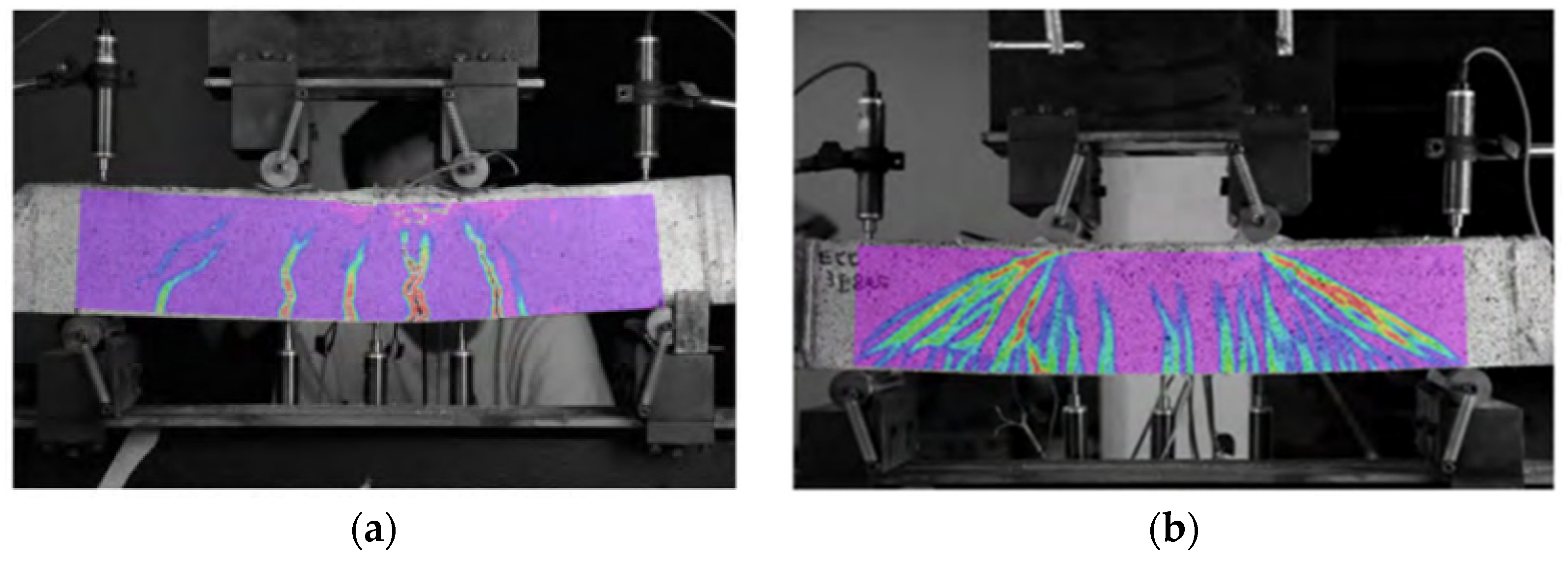
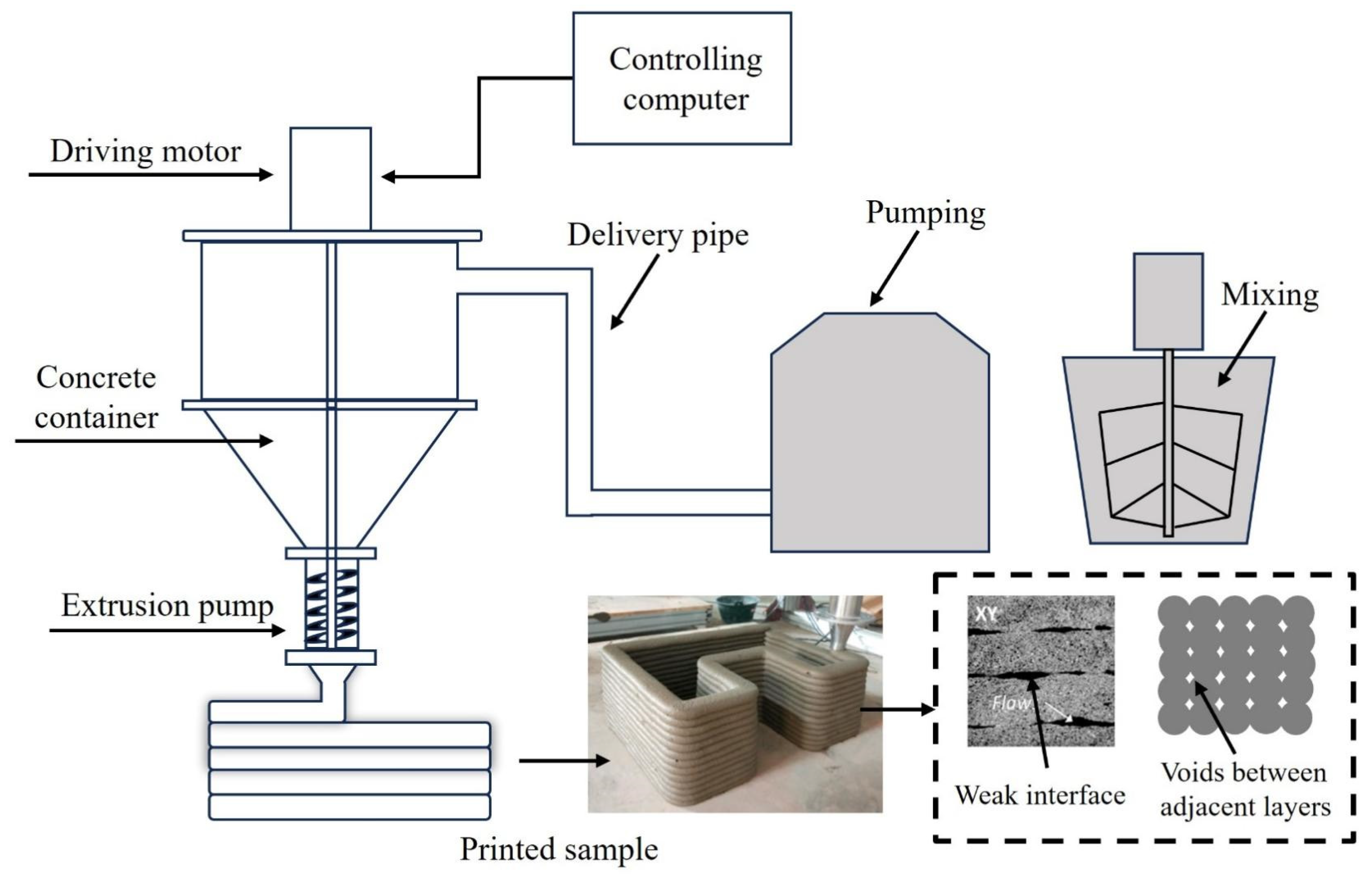


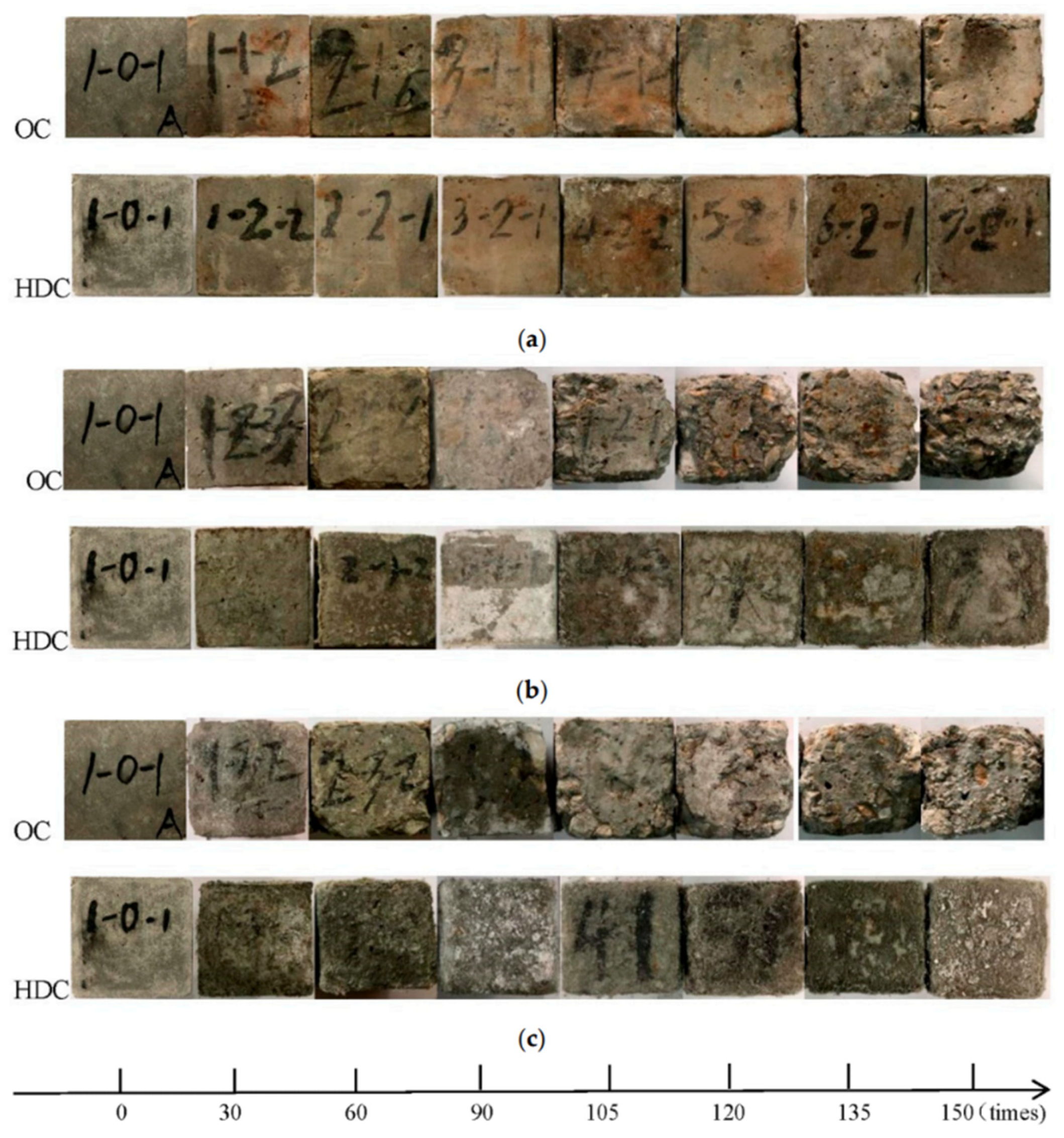


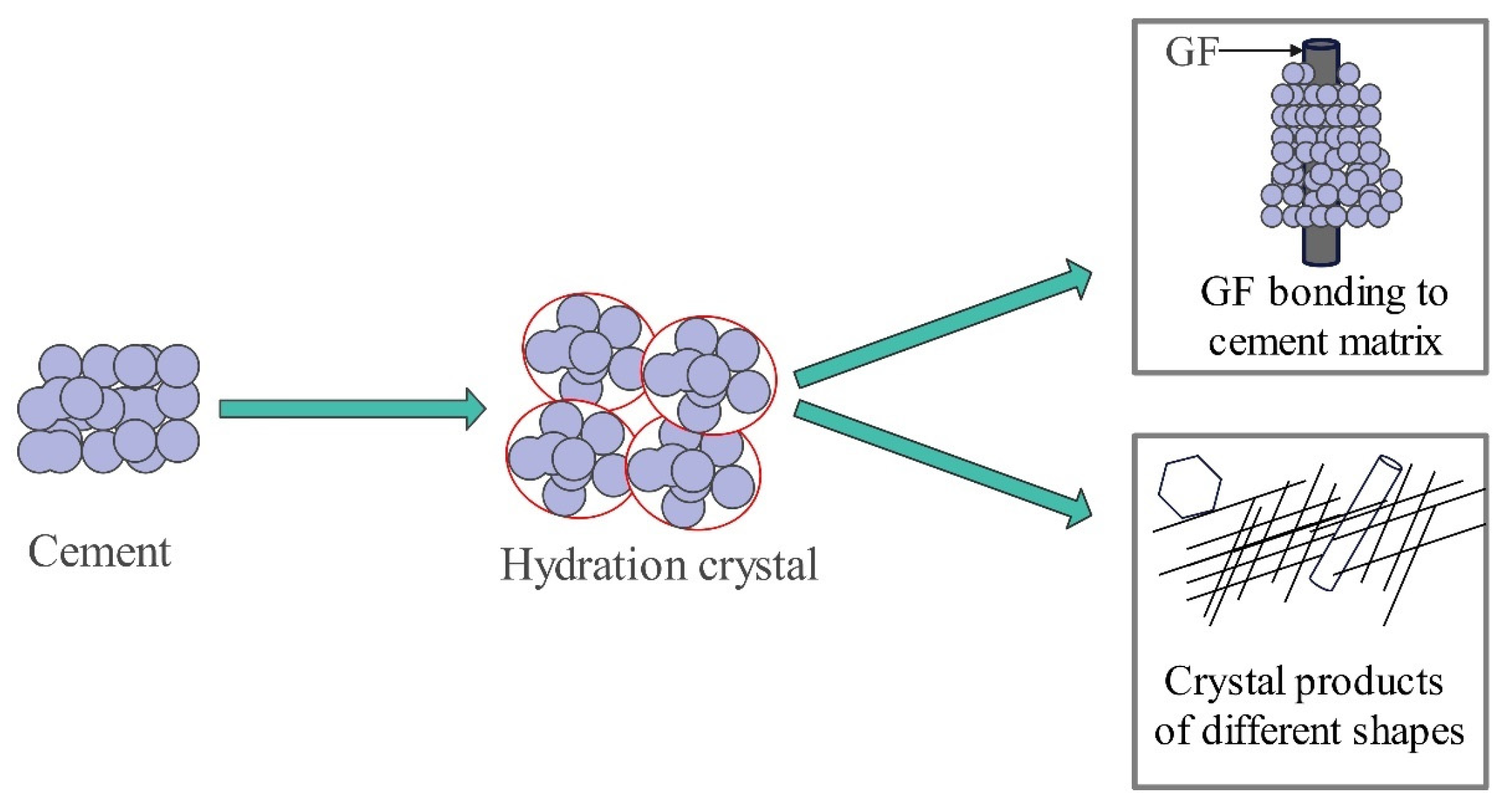


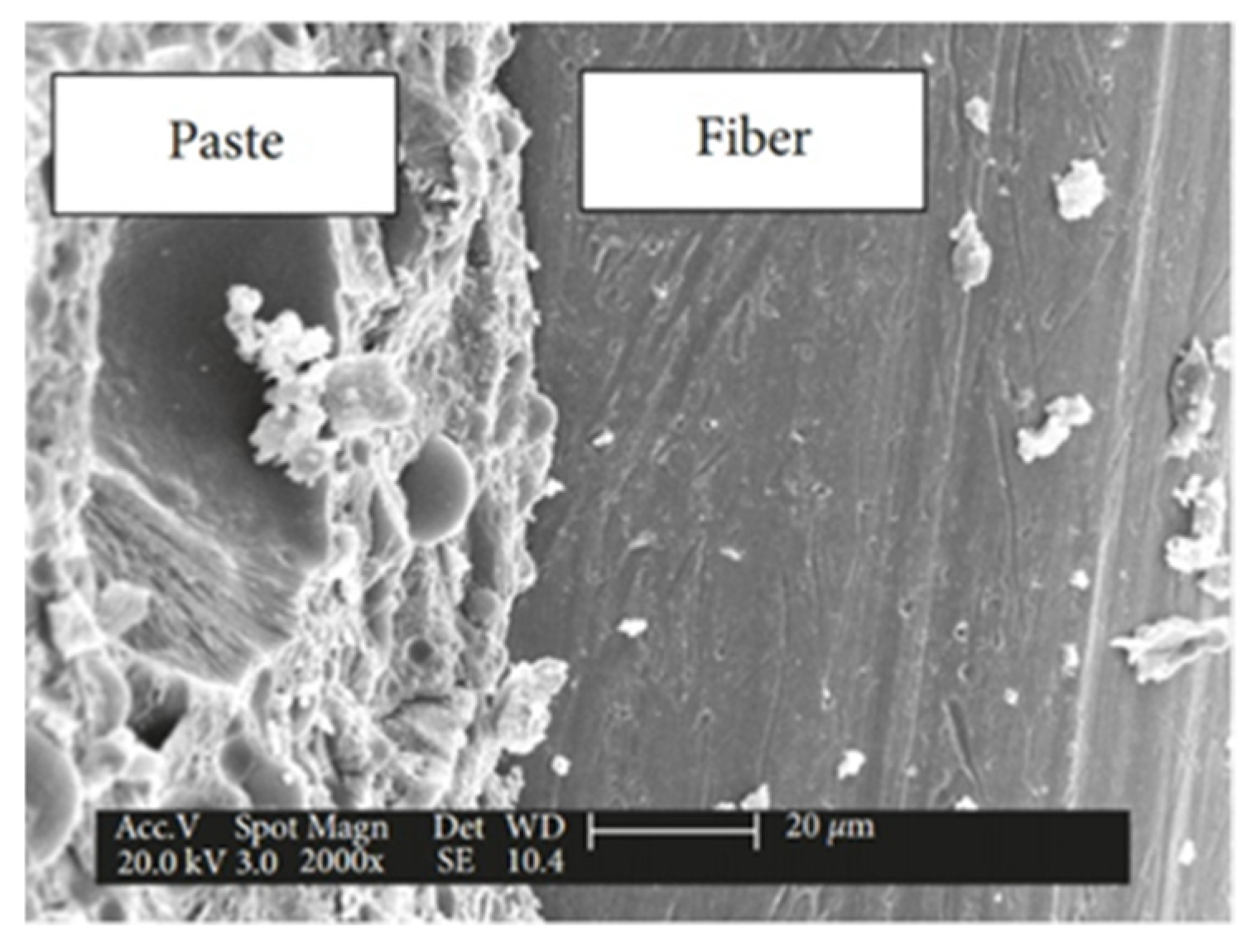

| Fiber Name | Length (mm) | Diameter (μm) | Density (g/cm3) | Tensile Strength (MPa) | Fusing Point (°C) | Modulus of Elasticity (Gpa) |
|---|---|---|---|---|---|---|
| PVA | 3~15 | 12~39 | 1.32 | 1600~2500 | 255~230 | 40~80 |
| PE | 3~15 | 7~35 | 0.96 | 2500~2800 | 124~138 | 70~80 |
| Fiber Volume Fraction (%) | Compressive Strength | Splitting Tensile Strength | Modulus of Rupture | |||
|---|---|---|---|---|---|---|
| Measured (MPa) | Strength-Effectiveness (%) | Measured (MPa) | Strength-Effectiveness (%) | Measured (MPa) | Strength-Effectiveness (%) | |
| 0 | 85 | - | 5.8 | - | 6.4 | - |
| 0.5 | 91 | 7.1 | 6.9 | 19.0 | 8.2 | 28.1 |
| 1.0 | 95 | 11.8 | 8.7 | 50.0 | 10.1 | 57.8 |
| 1.5 | 98 | 15.3 | 10.8 | 86.2 | 12.3 | 92.2 |
| 2.0 | 96 | 12.9 | 11.5 | 98.3 | 14.5 | 126.6 |
| Fiber Volume Fraction (%) | Compressive Strength | Splitting Tensile Strength | Modulus of Rupture | ||||||
|---|---|---|---|---|---|---|---|---|---|
| Predicted (MPa) | Measured (MPa) | Prediction Error (%) | Predicted (MPa) | Measured (MPa) | Prediction Error (%) | Predicted (MPa) | Measured (MPa) | Prediction Error (%) | |
| 0 | 85 | 85 | 0 | 5.8 | 5.8 | 0 | 6 | 6.4 | 0 |
| 0.5 | 91 | 91 | 0 | 7.3 | 6.9 | 5.80 | 8.2 | 8.2 | 0 |
| 1.0 | 95 | 95 | 0 | 8.8 | 8.7 | 1.15 | 10.2 | 10.1 | 0.99 |
| 1.5 | 97 | 98 | −1.02 | 10.3 | 10.8 | −4.63 | 12.3 | 12.3 | 0 |
| 2.0 | 96 | 96 | 0 | 11.7 | 11.5 | 1.74 | 14.5 | 14.5 | 0 |
Disclaimer/Publisher’s Note: The statements, opinions and data contained in all publications are solely those of the individual author(s) and contributor(s) and not of MDPI and/or the editor(s). MDPI and/or the editor(s) disclaim responsibility for any injury to people or property resulting from any ideas, methods, instructions or products referred to in the content. |
© 2024 by the authors. Licensee MDPI, Basel, Switzerland. This article is an open access article distributed under the terms and conditions of the Creative Commons Attribution (CC BY) license (https://creativecommons.org/licenses/by/4.0/).
Share and Cite
He, J.; Huang, Z.; Wang, X.; Xin, M.; Zhang, Y.; Lu, H. Advances in Highly Ductile Concrete Research. Materials 2024, 17, 4596. https://doi.org/10.3390/ma17184596
He J, Huang Z, Wang X, Xin M, Zhang Y, Lu H. Advances in Highly Ductile Concrete Research. Materials. 2024; 17(18):4596. https://doi.org/10.3390/ma17184596
Chicago/Turabian StyleHe, Jingjing, Zhibin Huang, Xuezhi Wang, Ming Xin, Yong Zhang, and Haodan Lu. 2024. "Advances in Highly Ductile Concrete Research" Materials 17, no. 18: 4596. https://doi.org/10.3390/ma17184596
APA StyleHe, J., Huang, Z., Wang, X., Xin, M., Zhang, Y., & Lu, H. (2024). Advances in Highly Ductile Concrete Research. Materials, 17(18), 4596. https://doi.org/10.3390/ma17184596






